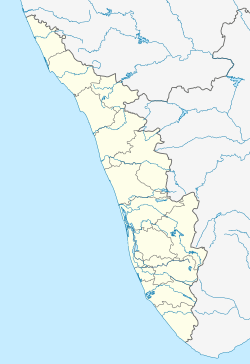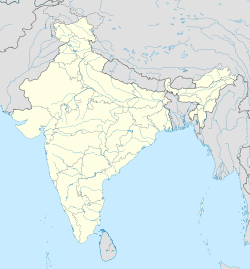Keezhukara facts for kids
Quick facts for kids
Keezhukara
|
|
|---|---|
|
village
|
|
| Country | |
| State | Kerala |
| District | Pathanamthitta |
| Population
(2008)
|
|
| • Total | 1,211 |
| Languages | |
| • Official | Malayalam, English |
| Time zone | UTC+5:30 (IST) |
| PIN |
689 641
|
| Telephone code | 91-468 |
| Vehicle registration | KL-03 |
| Lok Sabha constituency | Pathanamthitta |
Keezhukara is a small village in the Pathanamthitta area of Kerala, India. It is about 135 kilometers (84 miles) away from Thiruvananthapuram, which is the capital city of Kerala.
The village is located at 9.349 degrees North latitude and 76.705 degrees East longitude. The Pampa River flows along its northern and western sides. To the south, you'll find Kozhencherry, and to the east is Melukara. The inner parts of Keezhukara are hilly, but the land near the river is flat and good for farming. In 2008, about 1211 people lived in Keezhukara, in 292 homes.
Contents
A Look at Keezhukara's Past
In ancient times, Keezhukara was a thick jungle. Wild animals like jackals lived there freely. People didn't settle here permanently back then.
There was an old footpath that ran next to the river. This path connected Niranam all the way to Nilakkal. You can still see parts of this old path in Keezhukara today. People used it to bring things from the jungle to the river. From the river, these goods were sent by boat to Niranam, which was a busy trading port. Some of the items traded were pepper, Cinnamon, cardamom, ginger, sandalwood, teak, and rosewood. They also traded animals like peacocks, Apes, parrots, and even snakes, along with ivory.
Before the 1700s, there weren't many proper roads in Kerala. Rivers were the main way to travel, and people used country boats. At a place called Madathil Kadavu (Madathil ghat), the river becomes very wide. Here, the river changes direction, turning from east to south. During the dry season, a large sandy area would appear. This made it a great spot for boat travelers and merchants to stop and rest. Small shops and resting places were set up along the riverbank for them. These kinds of coffee shops were common at Madathil Kadavu until the mid-1900s.
By the 1700s, Keezhukara had become a peaceful village with many settlers. The people were hardworking and lived simple lives close to nature. They mostly earned money by farming and trading small goods. The villagers were either Hindus or Saint Thomas Christians. They lived together respectfully. There is a Hindu temple on top of a rock called Iruppakattu para. Christians used to worship at Niranam Orthodox church. Later, they built their own church nearby in Kozhencherry.
This village was once managed by a Brahmin family called an Illam. Every year, people had to pay taxes to the head of the Illam. These taxes were usually paid with farm products like paddy (rice) and coconuts. This way of collecting taxes continued until the 1950s.
How Roads Developed
The old route from Pandalam to Sabarimala goes through Kozhencherry. By the year 1900, there were two jungle paths from Kozhencherry to Keezhukara Madathil Kadavu.
One path started at the Kozhencherry junction and went past the old Kozhencherry church. It led down steps through a stone gateway to the Mulayodil paddy fields. From there, it was a small raised path through the fields. This path eventually joined another one that went from Madathil Kadavu to Melukara. Later, as new houses were built, a new path was made to go around the rocky hill.
During the rainy season, the old paths were hard to use. So, a new, straighter path was made through the hilly area from Kozhencherry to Road Kadavu. By the early 1900s, this road was made wider so that bullock-carts could reach the village. Between 1947 and 1950, a new road was built from Kozhencherry Market to Neduvelil Junction. This project was led by Mannil Mathew (Pappy).
Important Buildings
The Keezhukara YMCA Public Library is one of the oldest public libraries in Kerala. A branch of the YMCA was built in memory of Rev. P.E.Mathew. A prayer hall that was near the YMCA Library was taken down in the 1960s.
The primary school building and its land were given to the Government of Travancore. One condition was that the school building could still be used for Mar Thoma Sunday School classes on Sundays. St. Mary's Girls’ school provided education for girls living within a 10-kilometer (6-mile) area.
Until 1947, most houses in Keezhukara had roofs made of thatch. A typical house was built of wood. It usually had a granary (for storing grain) in the middle and two bedrooms on its sides. A long open porch in front served as a guest room, living room, and even a bedroom. Under the granary, there was an underground storage area. At the back, there was a room for pounding paddy, which also stored farm products. The kitchen was on one side of the house under a sloping roof. The thattinpuram (attic) was used for storage. Electricity came to Keezhukara by 1953.
Palliyodams: The Famous Snake Boats
Aranmula is about 5 kilometers (3 miles) from Keezhukara by river. Palliyodams are special snake boats, also known as Chundan Vallam. People who worship Lord Parthasarathy see these boats as sacred.
These Palliyodams belong to different villages, or karas, in Pathanamthitta District. The Keezhukara Palliyodam is owned by N.S.S. Karayogam No: 717. It is managed by a special committee called the Palliyoda Samrakshana Samithi, which means "snake boat maintenance committee."
A special thing about the Keezhukara palliyodam is that it shows how well people of different religions get along in the village. Everyone in the village helps, from building the boat to launching it and taking part in the yearly celebrations. If the boat wins a prize, the whole village celebrates together! The Aranmula boat race (Vallam Kali) is a big part of the culture of Kerala state, especially in Aranmula. Keezhukara is very proud to be a part of this amazing event.



